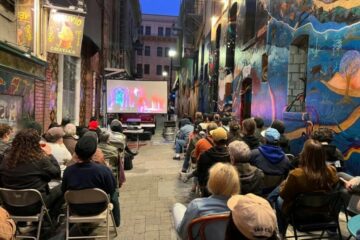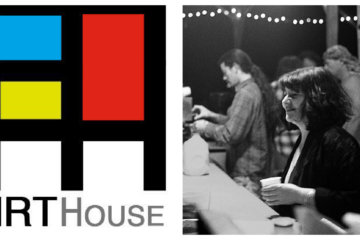The City That Was: An Inner City 4th
In The City That Was, Bohemian Archivist P Segal tells a weekly story of what you all missed: the days when artists, writers, musicians, and unemployed visionaries were playing hard in the city’s streets and paying the rent working part time.
We moved into 1907 Golden Gate with no knowledge of this inner city neighborhood that would be home to so many of us over the years. Because we knew absolutely nothing about the powerful community that had built up and thrived around 1907, we were totally surprised, on our first July 4 in the hood, by a cacophonous din rising from the street early in the day.
Bleary-eyed, the earliest 1907 risers took our first coffees over to the bay window in the all-redwood parlor and looked down at the street below. Outside, on the light posts, houses, and railings, we saw red, white, and blue bunting and the stars and stripes everywhere. Every household on our block of Golden Gate was setting up a banquet table, barbeques, café tables and chairs, shade structures, chafing dishes, plates, glasses, ice chests, and a huge, inflatable play structure for the children, who were shrieking in delight. Police barricades blocked the street from Baker to Broderick, so no cars could disrupt the festivities about to begin.
That part of the Western Addition, now known as NOPA, was largely home to black families that had bought inner city houses on the GI Bill after World War II. Generations had grown up in those houses; the kids had gone to school together, and eventually inherited those places they grew up in. There was already a strong neighborhood association in our corner of the Western Addition, but nowhere was there a stronger sense of history and community than on that block I was lucky enough to find.
Local Journalism for Working stiffs
We write for the poets, busboys, and bartenders. We cover workers, not ‘tech’, not the shiny ‘forbes 100 bullshit’. We write about the business on your corner and the beer in your hand. Join the Bay's best newsletter.
Most of the older residents of the street had moved to the west coast from the south, and each family had a signature barbeque sauce and dishes. Before noon, when the denizens of 1907 were barely thinking of breakfast, the heady scent of roasting meat perfumed the air coming in through the open windows. We watched in amazement as dozens of households brought out massive bowls of potato salad, heaps of rolls, greens, corn, and sweets, cases of soft drinks and beer that had been on ice for hours. It was foggy. Nothing new there. But our block was celebrating in style and in the fog.
When we finally got ourselves together to leave the house, our neighbors across the street waved us over. “Have some barbeque!” they called across the street, so we went over. All the neighbors had greeted us on the street for months, and we already knew a lot of them by name. Now they all wanted to feed us. And it was good.
All the years I lived at 1907, I could expect this annual event on my block. It seemed to get a little smaller, in the years before the tech bubble burst in 2000, because a lot of the old-time residents, or their heirs, suddenly had the chance to manifest a million dollars by selling their homes. But then other things became part of the neighborhood party, like music, bringing neighbors from other corners of the surrounding area.
In 2001, the newly formed band, The Pine Box Boys, played their very first public gig at the Golden Gate Avenue 4th of July party. The Pine Box Boys, and their alter-ego, The Graveside Quartet, have been called “dark grass” or “horrorbilly,” but they are most frequently called brilliant. Their principle songwriter is, after all, an inspired English teacher, who writes entertaining songs about murder and death, and they are four immensely talented musicians. They tour Europe a few times a year, where clubs have blown up their photos to wall size and turned the images of their visiting American entertainers into wallpaper. Another club fashioned their logo into metal, and mounted it prominently all over their bar. American fans have tattooed their images on each of their limbs. But a lot of people in their own city have never heard them.
In recent years, the 4th of July has not been celebrated on Golden Gate Avenue like in any public way, as neighbors sold out or were pushed out by circumstance. But the Pine Box Boys are still here, all living in a quarter-mile radius of Alamo Square. Not all the good stuff is gone.









